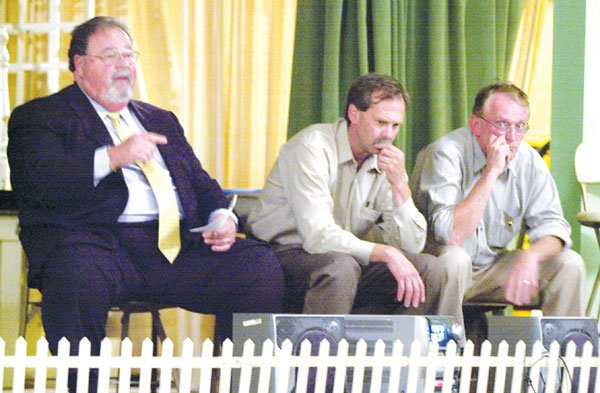GILROY
– The economic woes plaguing Santa Clara County may force the
closure of the popular 4-H Youth Development Program, according to
county officials who met with dozens of parents and some of their
children Tuesday night.
GILROY – The economic woes plaguing Santa Clara County may force the closure of the popular 4-H Youth Development Program, according to county officials who met with dozens of parents and some of their children Tuesday night.
But advocates of the program say they will do anything they can to save it from becoming a victim of the cuts. For now, they are being told to wait while the costs are worked out between the agencies responsible for it.
Representatives from the government agencies that administer the program were on hand Tuesday night, along with Santa Clara County Supervisor Don Gage, to reassure county residents that they are seeking creative solutions to keep 4-H and related programs off the chopping block. About 1,000 children are 4-H members.
“We’re not to a conclusion yet in terms of making it happen, but we’re getting closer,” said Gage, supervisor for District, which includes South County. “We’ve made some negotiations.”
The most likely solution at this point would be to move the 4-H and its sister programs into a county-owned building and cut back support staff.
At issue is nearly $240 million that must be cut from the county’s 2004-05 budget, “which is going to be tough,” Gage said.
As part of drastic reductions spanning all county departments, County Agricultural Commissioner Greg Van Wassenhove must reduce his department’s budget by $422,000, starting with programs that are not required by law or fully funded.
The only such program in his department is the University of California Cooperative Extension, an umbrella of six programs that includes 4-H, farm advisors and Master Gardeners.
“These are programs that are not core to the county,” Gage said. “These are programs that we feel are important for the health of our community, but those are the programs that are going to go first.”
All six programs cost the county $438,000, while the University of California contributes about $1.8 million. The federal government’s department of agriculture and grants make up the rest of its funding.
Van Wassenhove is looking for ways to cut and yet maintain all six programs because pulling 4-H – which costs the county about $20,000 – is not a likely option.
“We’re committed to staying in this county,” said Steve Nation, executive director of governmental and external relations for the University of California Department of Agriculture and Natural Resources. “We don’t want to be a partial program in the county, we want the county to provide the necessary services that people expect from us and expect from (it).”
The 16 people that make up the cooperative extension staff, paid by the UC, are currently housed in office space rented by the county. If the program moves from its Empey Way location into a vacant county-owned building on Burger Drive, the county would save about $240,000, or more than half of what the agriculture department needs to cut.
More can be saved by combining resources and sharing secretaries, leaving a $60,000 gap to save 4-H and other cooperative extension programs. Since more cuts are expected next year, the target now is to find about $120,000 in the county and UC budgets.
“That’s about how far we’re off if we assure we can move into a county building,” Van Wassenhove said. “I don’t know where it’s going to come from. “(Nation and I) are both looking into our programs for that $60,000 on either side.”
The Burger Drive building must be renovated before the programs can move in at the start of the next fiscal year on July 1, which Gage said he’ll push for. Even then, Van Wassenhove said, it will be a fight to get into the space coveted by other departments reeling from cuts.
Audience members Tuesday night offered various suggestions for ways to save the agricultural programs.
“The cost effectiveness of helping youth with programs like this – how do you put a dollar figure on it?” asked Deborah Lange, Santa Clara County 4-H key leader.
She said all the UC programs in the county must be saved because they offer valuable services, such as advice to farmers and nutrition education for families dependent on food stamps. Lange suggested eliminating secretarial positions and raising fees for other programs in the department that encroach on the general fund.
“That’s kind of where we are in the negotiation,” Gage said, although fees would . “That’s how close we are.”
Although the crowd of largely 4-H volunteers repeatedly asked to raise money and save the programs themselves, the cooperative representatives said that would be the last option looked at.
“Right now, what we’d like you to do is give us some patience while we work this out,” Gage said.
Jenny Midtgaard Derry, executive director of the county farm bureau, urged the three agencies to let county residents help out.
“We really use our farm advisors,” she said.
While painting a bleak picture of state budget cuts bearing down on the county and UC system, each of the representatives at Tuesday night’s meeting made it clear they are at the negotiating table to come to a mutual agreement.
“It seems like 4-H is such a meager issue, but we have to look at the county as a whole,” Gage said.
“We are committed to try to resolve this when the economy turns around the county will work to get us up to the funding level we were at before,” Nation said.
The extension program statewide has seen a 20 percent reduction in funding and cut 350 positions in the last three years, Nation said.
“We feel if we can make it for the next two years, we can start to restore these programs,” Gage said.













